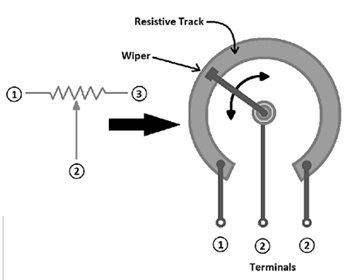3 minutes
Study of Potentiometers
Potentiometers: Study Notes
1. Introduction to Potentiometers
A potentiometer is a three-terminal resistor with a sliding or rotating contact that forms an adjustable voltage divider. The primary use of a potentiometer is to vary the resistance in a circuit without interrupting the flow of current. It is commonly used for adjusting electrical devices like volume controls on audio equipment.
Types of Potentiometers:
- Rotary Potentiometer: Has a circular rotation for adjusting resistance.
- Linear Potentiometer: The slider moves in a straight line.
2. Potentiometer Structure and Working Principle
A potentiometer has three main terminals:
- Terminal 1 (Fixed End): Connected to one end of the resistive track.
- Terminal 2 (Wiper): A movable contact sliding over the resistive track.
- Terminal 3 (Fixed End): Connected to the other end of the resistive track.
By rotating or sliding the wiper across the resistive material, the resistance between the wiper and each fixed end changes, effectively creating a variable resistor.
Potentiometer Image

3. Basic Calculations
The total resistance of a potentiometer is represented as R. The voltage division that occurs across the potentiometer can be calculated using the following formula:
[ V_{out} = V_{in} \times \frac{R_2}{R_1 + R_2} ]
Where:
- ( V_{in} ): Input voltage
- ( V_{out} ): Output voltage from the wiper
- ( R_1 ): Resistance from the fixed end to the wiper
- ( R_2 ): Resistance from the wiper to the other fixed end
For example, if ( R_1 = 5k\Omega ) and ( R_2 = 10k\Omega ), and the input voltage is ( 12V ), then:
[ V_{out} = 12V \times \frac{10k\Omega}{5k\Omega + 10k\Omega} = 8V ]
Internal Structure
The following image shows the internal structure of a rotary potentiometer:

4. Practical Applications
4.1 Volume Control in Audio Equipment
Potentiometers are widely used in audio devices to adjust the volume. By changing the resistance, the output audio signal is modified, thus increasing or decreasing the volume.
4.2 Dimmer Switches
They are used in lighting systems to control the brightness of lights by varying the voltage supplied to the bulbs.
4.3 Sensor Calibration
In sensor circuits, potentiometers can be used for fine-tuning sensitivity or thresholds, making the sensors more accurate in different environmental conditions.
5. Types of Potentiometers
5.1 Linear Potentiometer
Linear potentiometers provide a resistance change that is directly proportional to the position of the wiper.
5.2 Rotary Potentiometer
These potentiometers have a rotary knob that adjusts the resistance.
6. Advantages and Limitations
Advantages:
- Simple design
- Inexpensive
- Easily adjustable resistance
Limitations:
- Subject to wear and tear
- Limited precision compared to digital systems
- Mechanical movement can cause inaccuracies over time
7. Conclusion
Potentiometers are versatile and commonly used components in various electronics projects and devices. Understanding their working principle, types, and applications allows for effective implementation in circuits ranging from audio systems to sensor calibration.
460 Words
2024-10-21 18:56